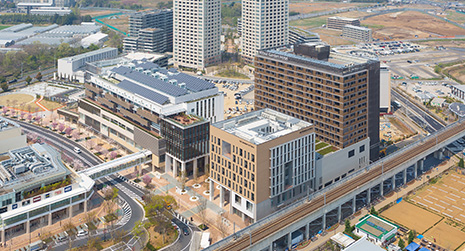Home > Highlighting JAPAN > Highlighting Japan September 2016 > Japan’s Fight Against Global Warming
Highlighting JAPAN


Smart Living in Kashiwa-no-ha
Kashiwa-no-ha Smart City in Chiba Prefecture demonstrates how energy can be saved and CO2 emissions reduced using a mixture of advanced technologies and common sense.
The development of Kashiwa-no-ha Smart City in Kashiwa, Chiba Prefecture, commenced in 2005 with a view to building an Environmentally Symbiotic City, a City of Health and Longevity and a City of New Industry Creation. To date, one-third of the development has been completed, and nearly 5,000 people live there. By 2023, the site, with an area of almost 300 hectares, will accommodate 26,000 residents.
One aspect of Kashiwa-no-ha Smart City which seeks to achieve the Environmentally Symbiotic City concept has been the adoption of an Area Energy Management System (AEMS). The system is designed to centralize energy for use in the community by using a network, with Kashiwa-no-ha Smart Center functioning as the central hub, to connect commercial complexes, hotels, offices, condos and other facilities throughout the area with grid power from electricity companies and power-generation equipment such as photovoltaic units and storage batteries.
“Analyzing data on the use of energy by different facilities and weather information allows for greater efficiency in energy use throughout the city,” says Makoto Chikazawa of the Kashiwa-no-ha Urban Planning and Development Department at Mitsui Fudosan. “This leads to energy savings and the reduction of CO2 emissions.”
In addition to AEMS, a smart grid is necessary for streamlining local energy use. The smart grid involves facilities’ sharing the electric power generated by or stored in equipment, such as solar power generators and storage batteries. Demand for electricity can vary significantly depending on the weather and the day of the week. For example, on weekdays, the smart grid provides more electricity to offices than to commercial complexes, and does exactly the opposite on weekends. Through these efforts, the rate of so-called peak shaving in the community has reached nearly 26%.
Residences in the community are equipped with the Home Energy Management System (HEMS). This system enables residents to confirm the amount of electricity, water and hot water used in their house, their electric bills and the consumption of electricity in the town overall by using a dedicated tablet, a computer or a smartphone. The artificial intelligence (AI) function is also capable of receiving advice on saving energy via terminals in accordance with each resident’s lifestyle and without compromising comfort. As an alternative to money, residents can also receive Kashiwa-no-ha Points as they successfully reduce CO2 emissions through their energy-saving efforts. These points can be used at community events and shopping.
“Visualizing energy can raise residents’ awareness of energy saving,” says Chikazawa.
Facilities such as commercial complexes, offices and hotels have equipment for natural energy such as solar, wind and geothermal power generation, and biomass power generation using raw garbage. Many different methods of controlling energy consumption are also in use in these facilities. For example, roofs and walls are greened for the purpose of preventing temperature rises in buildings. LED illumination with lower power consumption has been introduced. Optical ducts for diverting outside light indoors have also been installed to control the amount of indoor lighting used. By combining these devices with AEMS, buildings accommodating shops and offices have reduced their CO2 emissions by nearly 50% compared with regular buildings of the same size.
Through efforts such as the continued enhancement of AEMS and the introduction of more solar power generation, Kashiwa-no-ha Smart City aims to reduce CO2 emissions by almost 60% by 2030 in comparison with the conventional processes of town development.
The efforts made in Kashiwa-no-ha Smart City have garnered widespread domestic and international media interest. Three thousand people visit the Smart City annually, nearly 20% of whom come from overseas.
“Visitors’ interest in AEMS is particularly high,” says Chikazawa. “The global dissemination of the mechanism of consuming energy wisely on a regional basis will help reduce energy demand around the world.”
© 2009 Cabinet Office, Government of Japan







